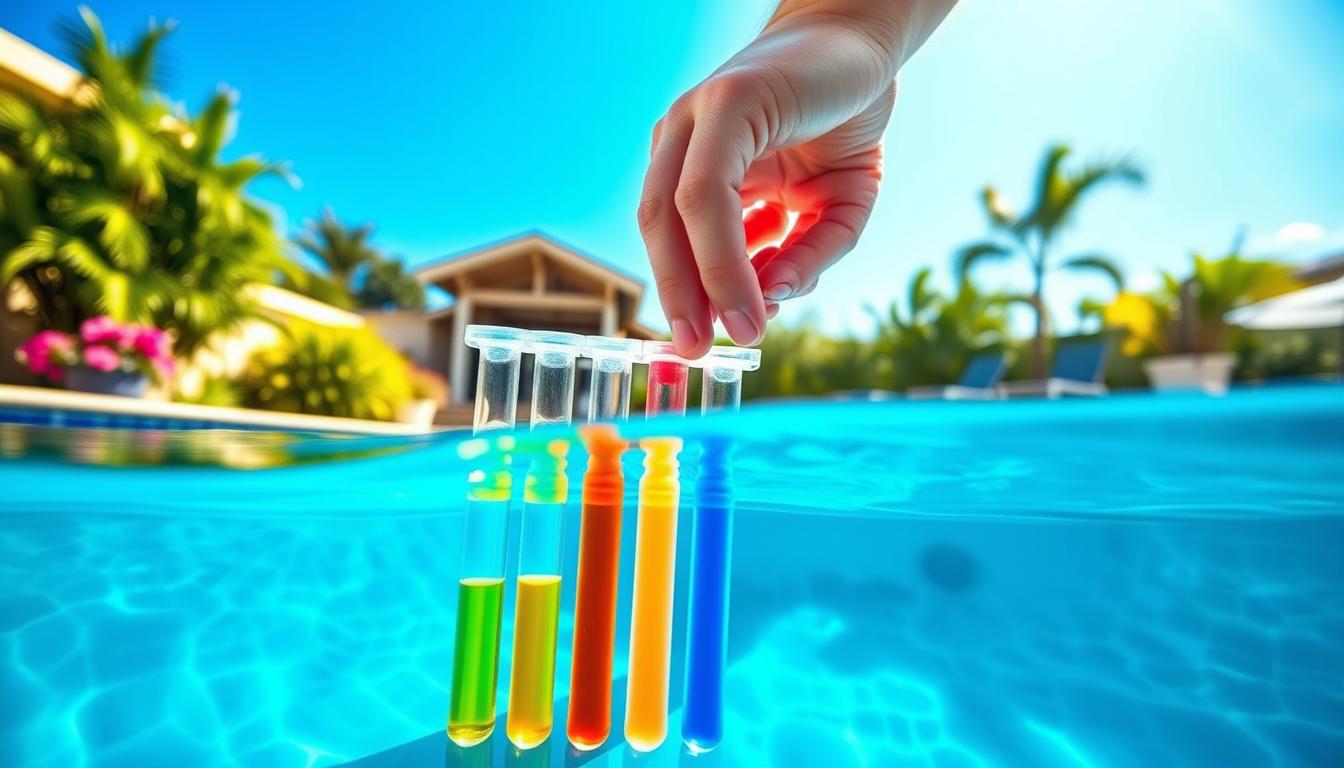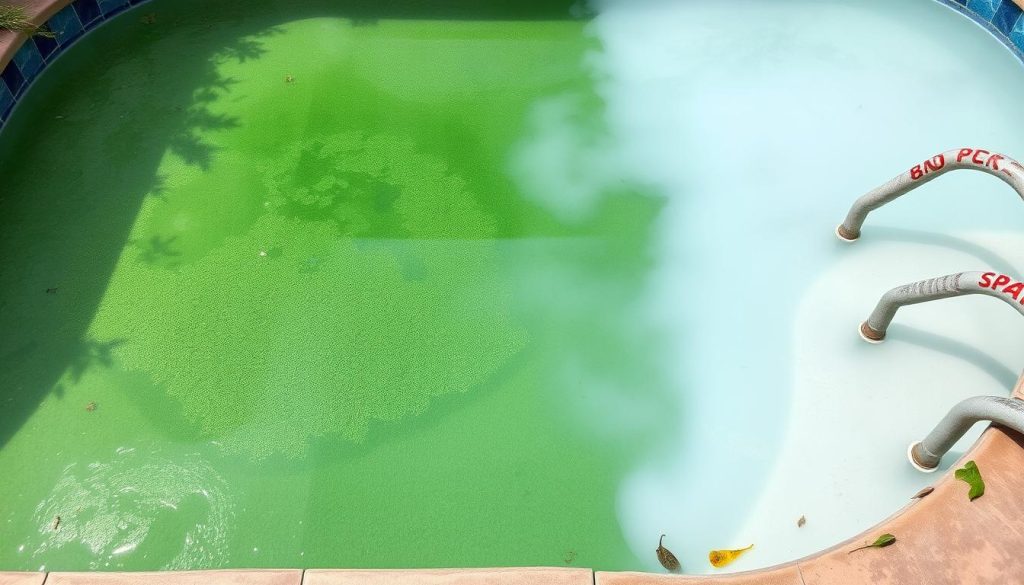
Pool chemistry can be tricky. Alkalinity plays a key role in maintaining the perfect balance. Let’s explore what alkalinity does for your pool and why it matters.
Alkalinity is the unsung hero of pool chemistry. It keeps pH levels stable and prevents drastic changes. This stability protects swimmers and equipment from harm.
The right alkalinity levels create an ideal environment for other chemicals. This ensures crystal-clear water and a safe swimming experience. Proper alkalinity management is crucial for a healthy pool.
We’ll explore alkalinity’s definition, ideal range, and the effects of imbalance. You’ll also learn tips for managing your pool’s alkalinity effectively. This knowledge will help you enjoy your backyard oasis worry-free.
Understanding Pool Alkalinity
Pool alkalinity is vital for safe, comfortable swimming. It keeps water chemistry balanced. Let’s explore what alkalinity is and how it affects our pools.
Understanding alkalinity helps us maintain well-balanced pools. We can avoid problems caused by imbalanced water. Regular checks ensure a great swimming experience.
Definition of Pool Alkalinity
Pool alkalinity measures alkaline substances in water. These are mainly ionic compounds that act as buffers. They resist changes in pH, stabilizing the water’s balance.
Alkalinity is measured in parts per million (ppm). It’s a key part of pool water chemistry. Proper alkalinity prevents sudden pH shifts that can cause problems.
Alkalinity is like a safety net for your pool’s pH levels, helping to keep them stable and preventing rapid fluctuations that can cause issues for swimmers and pool equipment.
Ideal Range for Pool Alkalinity
The ideal total alkalinity (TA) for pools is 80-120 ppm. This range allows effective pH control. It prevents issues linked to high or low alkalinity levels.
| Alkalinity Level | Range (ppm) | Effects on Pool Water |
|---|---|---|
| Low Alkalinity | Below 80 | Rapid pH swings, corrosion, etching |
| Ideal Range | 80-120 | Stable pH, clear water, swimmer comfort |
| High Alkalinity | Above 120 | Difficult pH adjustment, cloudy water, scaling |
Test pool alkalinity at least once a week. This helps maintain the ideal range. Quick action can fix any imbalances and keep water chemistry right.
Regular maintenance prevents problems from low or high alkalinity. It ensures safe, enjoyable swimming for everyone. Keep your pool balanced for the best experience.
The Importance of Balanced Total Alkalinity (TA)
Balanced total alkalinity (TA) is crucial for a safe and comfortable pool. The ideal range is 80-120 ppm. Regular testing and adjusting of TA is vital for proper pool care.
Balanced TA affects water clarity, swimmer comfort, sanitization, and equipment protection. It’s key to maintaining a well-functioning swimming environment.
Water Clarity and Stability
Balanced TA prevents rapid pH changes and mineral buildup. It keeps pool water clear and free from scaling. Stable pH levels, influenced by proper alkalinity, enhance your pool’s overall appeal.
Swimmer Comfort and Safety
Proper TA levels ensure swimmer comfort and safety. Imbalanced TA can irritate skin and eyes. Maintaining balanced TA creates a pleasant swimming experience without health risks.
Effective Sanitization
Balanced alkalinity supports effective sanitization. It helps chlorine and other sanitizers work efficiently. This keeps your pool clean and safe from harmful microorganisms.
Protecting Your Pool Equipment and Surfaces
Balanced TA protects pool equipment and surfaces from damage. Low alkalinity can corrode metal components. High alkalinity can cause scaling on surfaces and equipment.
Proper TA levels extend the lifespan of your pool equipment. This saves money on costly repairs and replacements in the long run.
| Parameter | Ideal Range | Effects of Imbalance |
|---|---|---|
| Total Alkalinity (TA) | 80-120 ppm | Rapid pH fluctuations, cloudy water, scaling, corrosion |
| pH | 7.2-7.6 | Swimmer discomfort, ineffective sanitization, equipment damage |
| Calcium Hardness (CH) | 200-400 ppm | Scaling, cloudy water, equipment damage |
Regular TA testing and adjusting maintains a balanced swimming environment. It promotes water clarity, swimmer comfort, and equipment longevity. Proper pool maintenance, focusing on alkalinity, ensures an enjoyable and cost-effective pool experience.
Consequences of Imbalanced Pool Alkalinity
Proper pool alkalinity is vital for a safe and comfortable swimming environment. The ideal range is 80 to 120 parts per million (ppm). Imbalanced levels can cause problems for water quality and pool equipment.

Consequences of Low Alkalinity
Low alkalinity in pools can make swimming less enjoyable and harm your pool. It can cause rapid pH swings and increase corrosion of metal components.
Low alkalinity can also lead to etching of pool surfaces. This creates a rough and uncomfortable swimming experience. It can reduce the effectiveness of chlorine, allowing bacteria to thrive.
- Rapid pH swings, making it difficult to maintain stable water chemistry
- Increased corrosion of metal components, such as ladders, railings, and pool equipment
- Etching and pitting of pool surfaces, leading to a rough and uncomfortable swimming experience
- Reduced effectiveness of chlorine and other sanitizers, allowing bacteria and algae to thrive
- Skin and eye irritation for swimmers due to the acidic water
Problems Associated with High Alkalinity
High alkalinity can also create issues affecting water clarity and pool health. It can cause cloudy water due to calcium carbonate scale formation.
Scale buildup can clog pipes and filters, reducing circulation. High alkalinity makes it hard to adjust pH levels. It can also decrease the effectiveness of sanitizers.
- Cloudy or hazy water due to the formation of calcium carbonate scale
- Reduced circulation and filtration efficiency, as the scale buildup can clog pipes and filters
- Difficulty in adjusting pH levels, as high alkalinity acts as a buffer against changes
- Decreased disinfection efficiency, as high pH levels can render chlorine and other sanitizers less effective
- Scale formation on pool surfaces, making them rough and unsightly
Imbalanced alkalinity levels can lead to a range of problems that affect water quality, swimmer comfort, and pool equipment longevity. Regular testing and adjustment of alkalinity levels is essential for maintaining a safe and enjoyable swimming environment.
Regular testing and adjustment of alkalinity levels are crucial. This helps maintain a safe and enjoyable swimming environment. It ensures your pool remains inviting for you and your family.
Maintaining Balanced Pool Alkalinity
Keeping your pool water safe and clear requires balanced alkalinity between 80 and 120 ppm. Test your pool’s alkalinity regularly using reliable test strips or a chemical test kit. This ensures optimal levels for a comfortable swimming experience.
Low alkalinity? Add sodium bicarbonate to raise it. Use 1.5 pounds per 10,000 gallons of water. For high alkalinity, gradually add muriatic acid or sodium bisulfate. Follow product instructions carefully to avoid overcorrection.
Retest the water after each adjustment. Repeat until alkalinity stabilizes within the ideal range. Persistent issues? Seek help from a pool professional.
Proper pool alkalinity ensures safe swimming and protects your equipment. It also guards surfaces from damage caused by imbalanced water chemistry. Regular maintenance keeps your pool enjoyable all season long.







